Operations Management: Bullwhip Effect and P&G's Transformation
VerifiedAdded on 2023/06/05
|8
|1516
|292
Report
AI Summary
This report examines the bullwhip effect in operations management, using Procter & Gamble (P&G) as a case study. It begins with an introduction to P&G, followed by a definition of the bullwhip effect and its impact on supply chains. The report then details P&G's implementation of strategies to mitigate the bullwhip effect, focusing on their collaboration with Wal-Mart and the use of technologies such as EDI, CPFR, and VMI. The analysis highlights how P&G transformed its supply chain by improving information sharing and coordination among partners. The report also discusses discrepancies between theoretical concepts and real-world challenges. The report concludes by summarizing the key findings, emphasizing the importance of collaboration and information management in achieving supply chain efficiency and reducing the negative consequences of the bullwhip effect, such as poor customer service and excessive inventory costs.
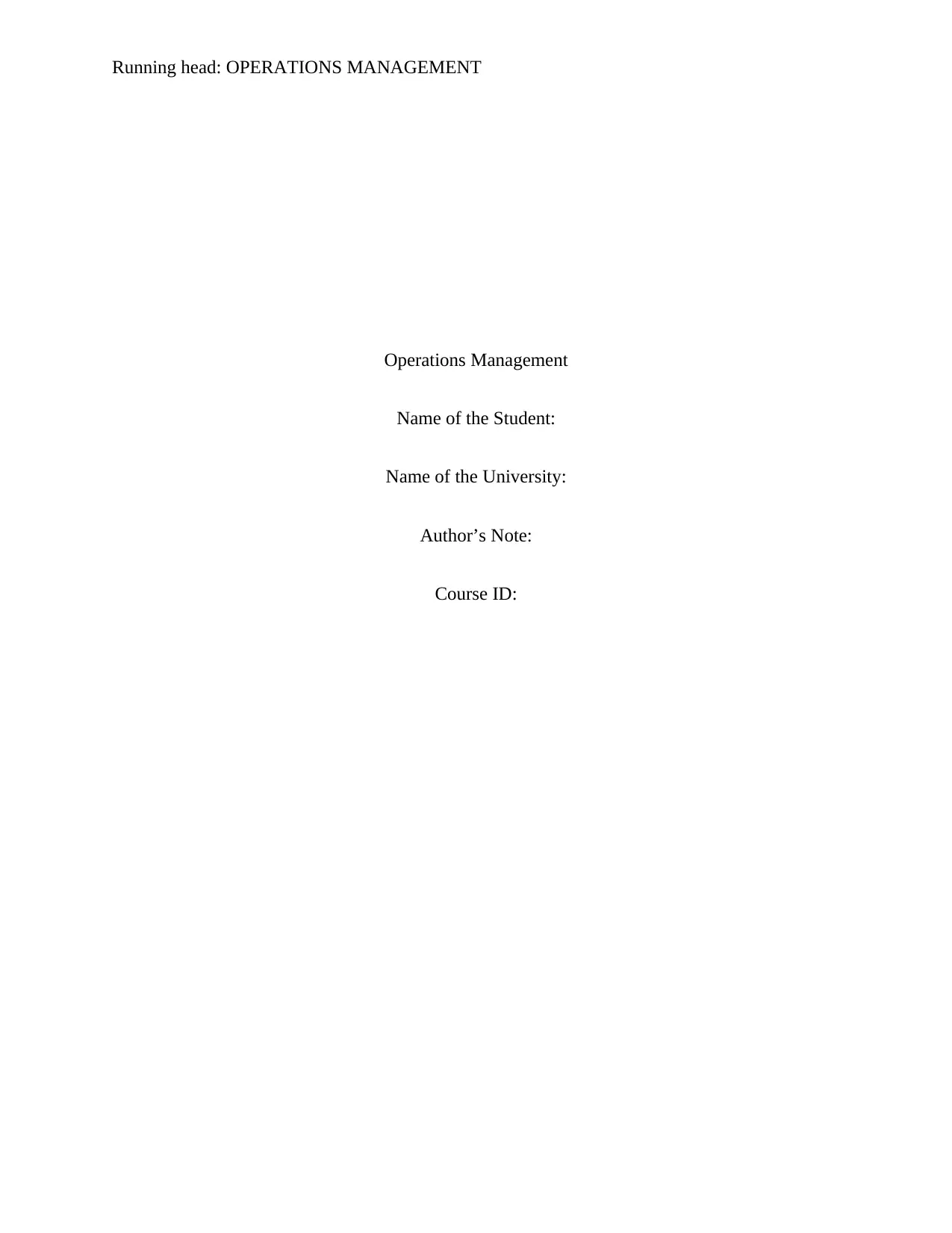
Running head: OPERATIONS MANAGEMENT
Operations Management
Name of the Student:
Name of the University:
Author’s Note:
Course ID:
Operations Management
Name of the Student:
Name of the University:
Author’s Note:
Course ID:
Paraphrase This Document
Need a fresh take? Get an instant paraphrase of this document with our AI Paraphraser
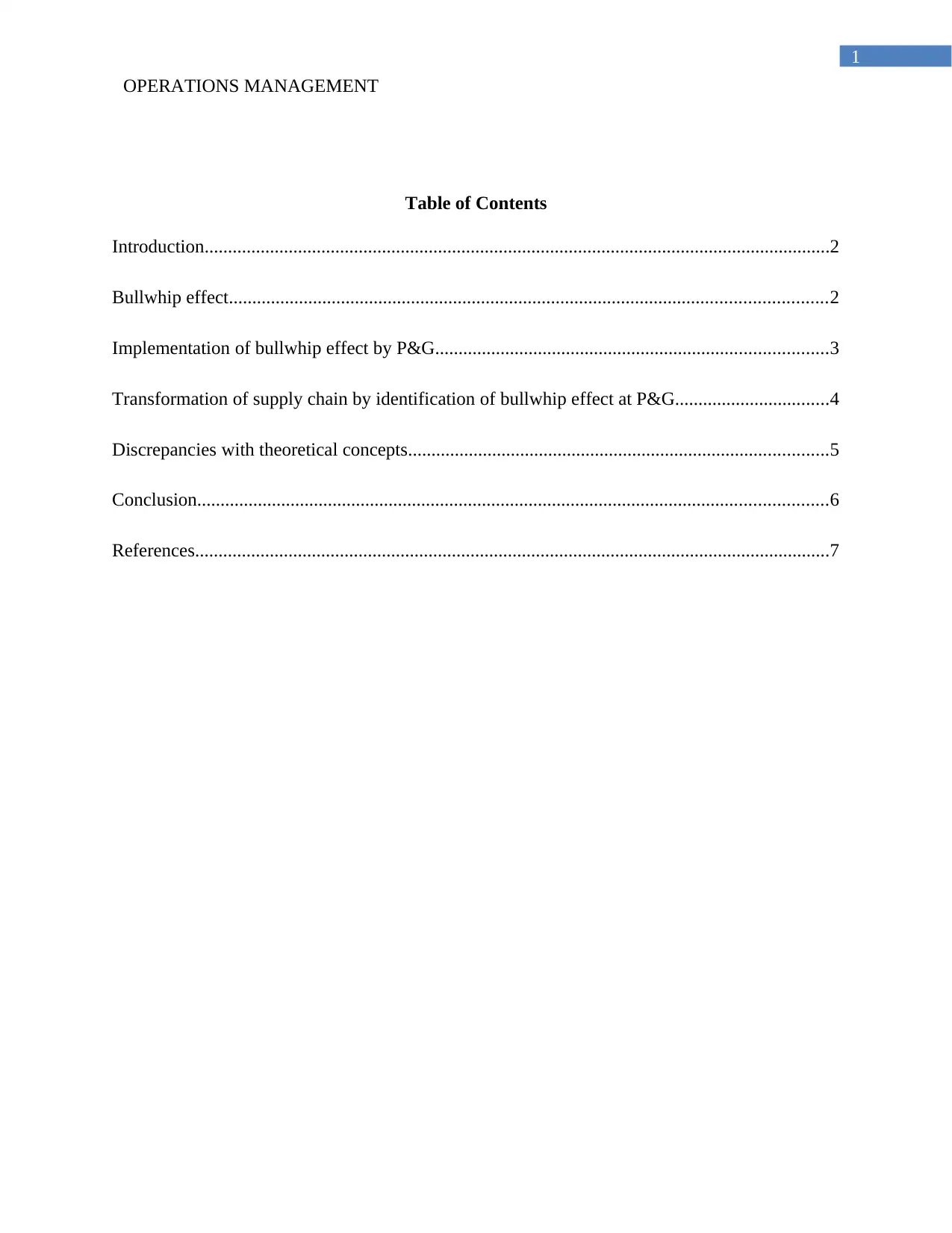
1
OPERATIONS MANAGEMENT
Table of Contents
Introduction......................................................................................................................................2
Bullwhip effect................................................................................................................................2
Implementation of bullwhip effect by P&G....................................................................................3
Transformation of supply chain by identification of bullwhip effect at P&G.................................4
Discrepancies with theoretical concepts..........................................................................................5
Conclusion.......................................................................................................................................6
References........................................................................................................................................7
OPERATIONS MANAGEMENT
Table of Contents
Introduction......................................................................................................................................2
Bullwhip effect................................................................................................................................2
Implementation of bullwhip effect by P&G....................................................................................3
Transformation of supply chain by identification of bullwhip effect at P&G.................................4
Discrepancies with theoretical concepts..........................................................................................5
Conclusion.......................................................................................................................................6
References........................................................................................................................................7
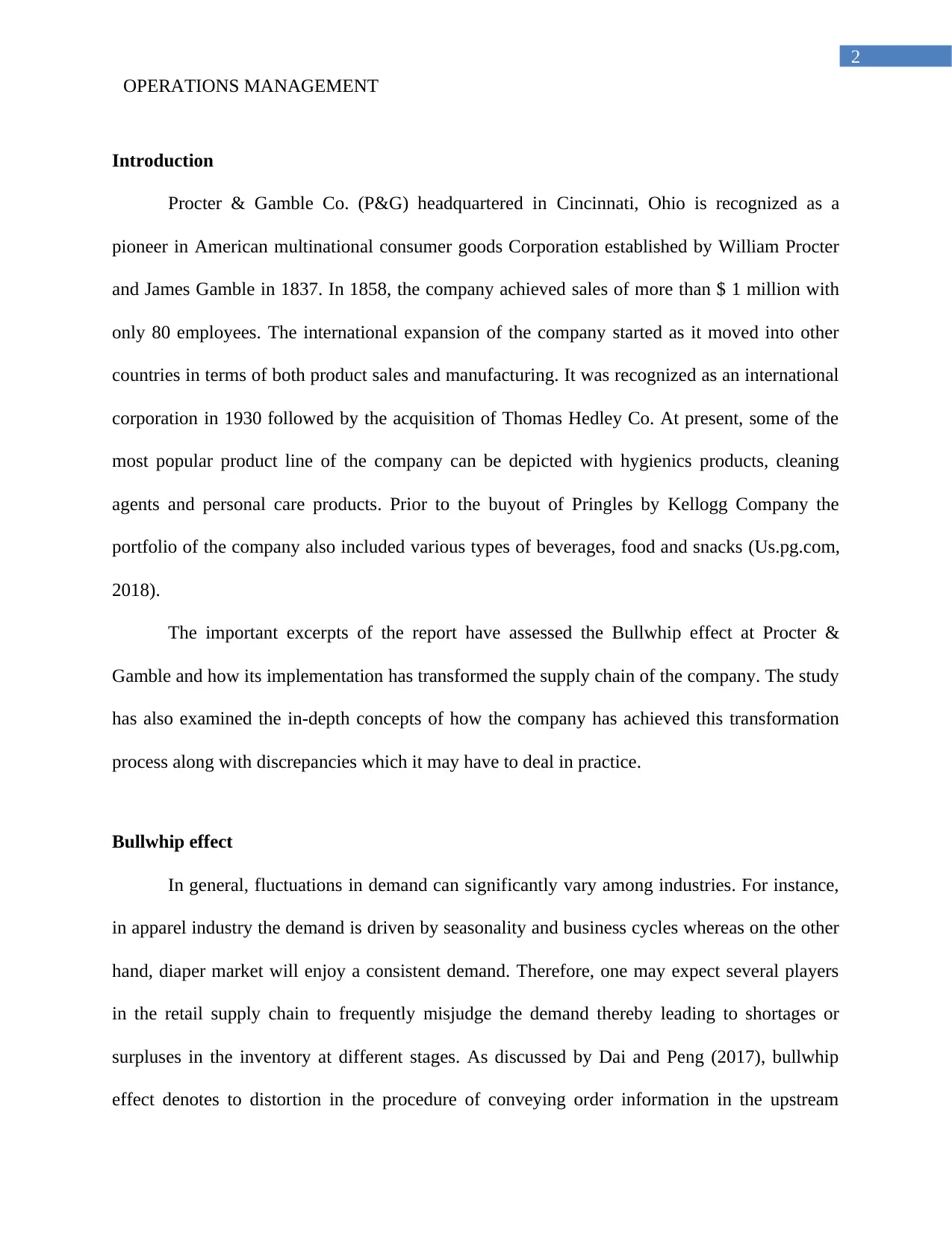
2
OPERATIONS MANAGEMENT
Introduction
Procter & Gamble Co. (P&G) headquartered in Cincinnati, Ohio is recognized as a
pioneer in American multinational consumer goods Corporation established by William Procter
and James Gamble in 1837. In 1858, the company achieved sales of more than $ 1 million with
only 80 employees. The international expansion of the company started as it moved into other
countries in terms of both product sales and manufacturing. It was recognized as an international
corporation in 1930 followed by the acquisition of Thomas Hedley Co. At present, some of the
most popular product line of the company can be depicted with hygienics products, cleaning
agents and personal care products. Prior to the buyout of Pringles by Kellogg Company the
portfolio of the company also included various types of beverages, food and snacks (Us.pg.com,
2018).
The important excerpts of the report have assessed the Bullwhip effect at Procter &
Gamble and how its implementation has transformed the supply chain of the company. The study
has also examined the in-depth concepts of how the company has achieved this transformation
process along with discrepancies which it may have to deal in practice.
Bullwhip effect
In general, fluctuations in demand can significantly vary among industries. For instance,
in apparel industry the demand is driven by seasonality and business cycles whereas on the other
hand, diaper market will enjoy a consistent demand. Therefore, one may expect several players
in the retail supply chain to frequently misjudge the demand thereby leading to shortages or
surpluses in the inventory at different stages. As discussed by Dai and Peng (2017), bullwhip
effect denotes to distortion in the procedure of conveying order information in the upstream
OPERATIONS MANAGEMENT
Introduction
Procter & Gamble Co. (P&G) headquartered in Cincinnati, Ohio is recognized as a
pioneer in American multinational consumer goods Corporation established by William Procter
and James Gamble in 1837. In 1858, the company achieved sales of more than $ 1 million with
only 80 employees. The international expansion of the company started as it moved into other
countries in terms of both product sales and manufacturing. It was recognized as an international
corporation in 1930 followed by the acquisition of Thomas Hedley Co. At present, some of the
most popular product line of the company can be depicted with hygienics products, cleaning
agents and personal care products. Prior to the buyout of Pringles by Kellogg Company the
portfolio of the company also included various types of beverages, food and snacks (Us.pg.com,
2018).
The important excerpts of the report have assessed the Bullwhip effect at Procter &
Gamble and how its implementation has transformed the supply chain of the company. The study
has also examined the in-depth concepts of how the company has achieved this transformation
process along with discrepancies which it may have to deal in practice.
Bullwhip effect
In general, fluctuations in demand can significantly vary among industries. For instance,
in apparel industry the demand is driven by seasonality and business cycles whereas on the other
hand, diaper market will enjoy a consistent demand. Therefore, one may expect several players
in the retail supply chain to frequently misjudge the demand thereby leading to shortages or
surpluses in the inventory at different stages. As discussed by Dai and Peng (2017), bullwhip
effect denotes to distortion in the procedure of conveying order information in the upstream
⊘ This is a preview!⊘
Do you want full access?
Subscribe today to unlock all pages.

Trusted by 1+ million students worldwide
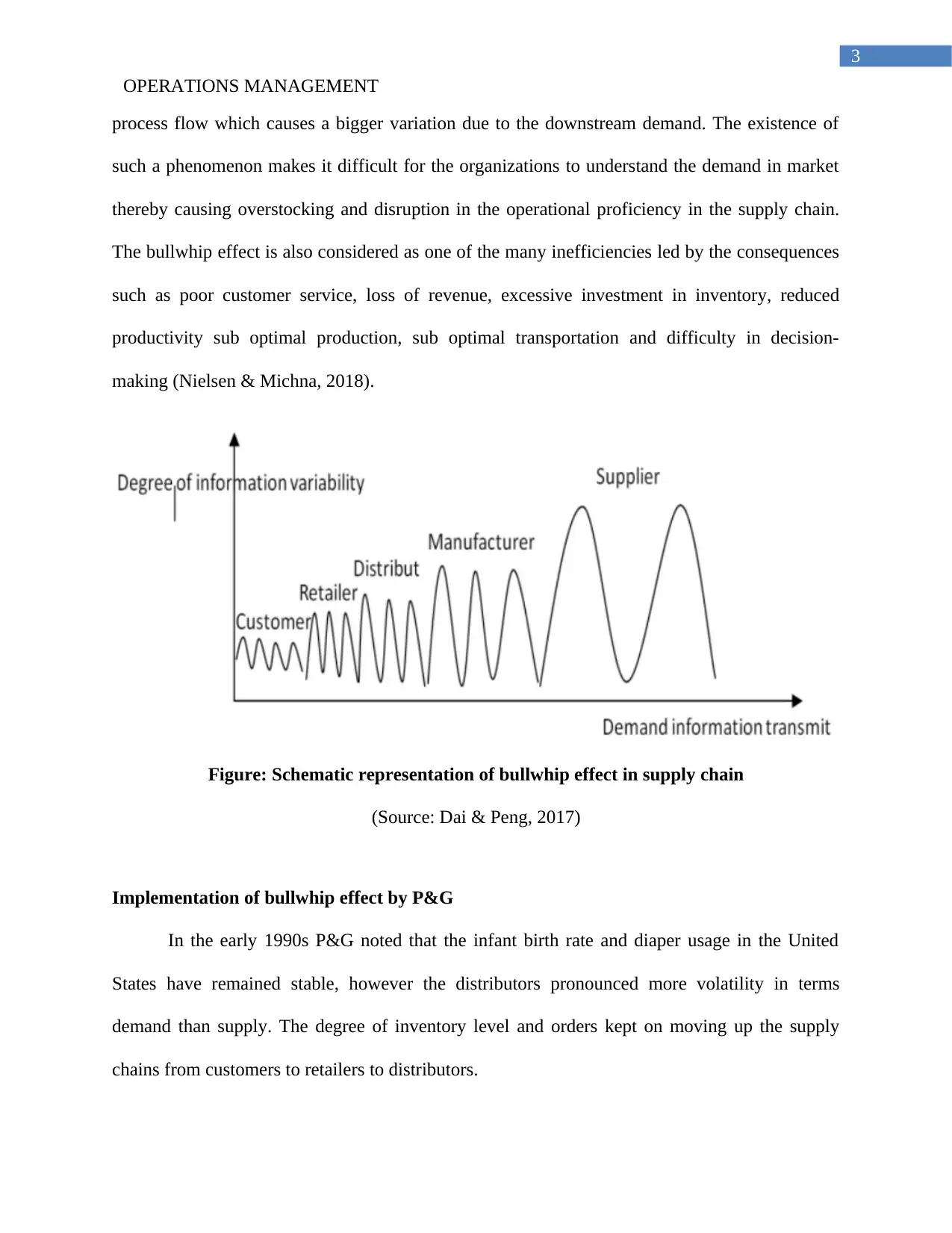
3
OPERATIONS MANAGEMENT
process flow which causes a bigger variation due to the downstream demand. The existence of
such a phenomenon makes it difficult for the organizations to understand the demand in market
thereby causing overstocking and disruption in the operational proficiency in the supply chain.
The bullwhip effect is also considered as one of the many inefficiencies led by the consequences
such as poor customer service, loss of revenue, excessive investment in inventory, reduced
productivity sub optimal production, sub optimal transportation and difficulty in decision-
making (Nielsen & Michna, 2018).
Figure: Schematic representation of bullwhip effect in supply chain
(Source: Dai & Peng, 2017)
Implementation of bullwhip effect by P&G
In the early 1990s P&G noted that the infant birth rate and diaper usage in the United
States have remained stable, however the distributors pronounced more volatility in terms
demand than supply. The degree of inventory level and orders kept on moving up the supply
chains from customers to retailers to distributors.
OPERATIONS MANAGEMENT
process flow which causes a bigger variation due to the downstream demand. The existence of
such a phenomenon makes it difficult for the organizations to understand the demand in market
thereby causing overstocking and disruption in the operational proficiency in the supply chain.
The bullwhip effect is also considered as one of the many inefficiencies led by the consequences
such as poor customer service, loss of revenue, excessive investment in inventory, reduced
productivity sub optimal production, sub optimal transportation and difficulty in decision-
making (Nielsen & Michna, 2018).
Figure: Schematic representation of bullwhip effect in supply chain
(Source: Dai & Peng, 2017)
Implementation of bullwhip effect by P&G
In the early 1990s P&G noted that the infant birth rate and diaper usage in the United
States have remained stable, however the distributors pronounced more volatility in terms
demand than supply. The degree of inventory level and orders kept on moving up the supply
chains from customers to retailers to distributors.
Paraphrase This Document
Need a fresh take? Get an instant paraphrase of this document with our AI Paraphraser
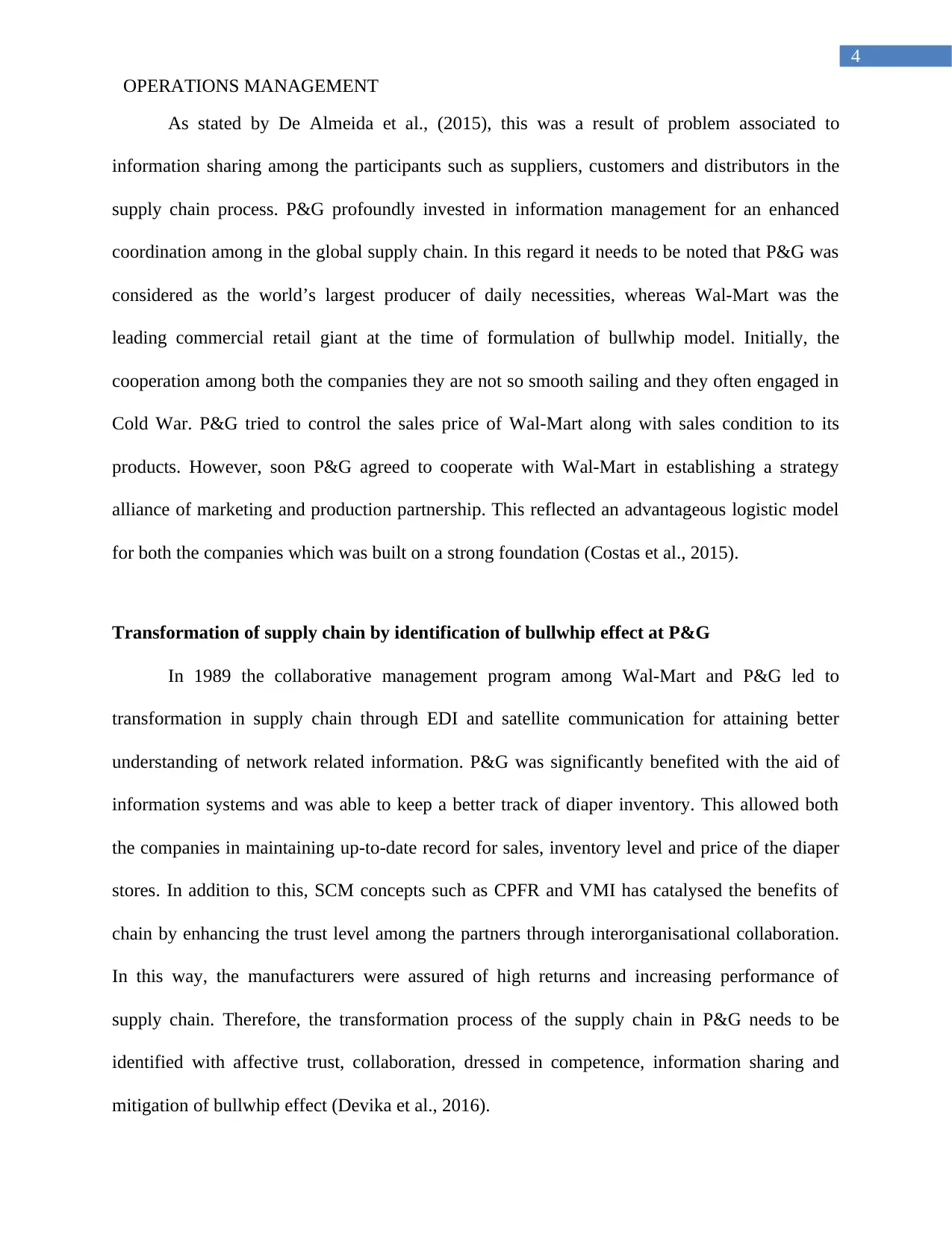
4
OPERATIONS MANAGEMENT
As stated by De Almeida et al., (2015), this was a result of problem associated to
information sharing among the participants such as suppliers, customers and distributors in the
supply chain process. P&G profoundly invested in information management for an enhanced
coordination among in the global supply chain. In this regard it needs to be noted that P&G was
considered as the world’s largest producer of daily necessities, whereas Wal-Mart was the
leading commercial retail giant at the time of formulation of bullwhip model. Initially, the
cooperation among both the companies they are not so smooth sailing and they often engaged in
Cold War. P&G tried to control the sales price of Wal-Mart along with sales condition to its
products. However, soon P&G agreed to cooperate with Wal-Mart in establishing a strategy
alliance of marketing and production partnership. This reflected an advantageous logistic model
for both the companies which was built on a strong foundation (Costas et al., 2015).
Transformation of supply chain by identification of bullwhip effect at P&G
In 1989 the collaborative management program among Wal-Mart and P&G led to
transformation in supply chain through EDI and satellite communication for attaining better
understanding of network related information. P&G was significantly benefited with the aid of
information systems and was able to keep a better track of diaper inventory. This allowed both
the companies in maintaining up-to-date record for sales, inventory level and price of the diaper
stores. In addition to this, SCM concepts such as CPFR and VMI has catalysed the benefits of
chain by enhancing the trust level among the partners through interorganisational collaboration.
In this way, the manufacturers were assured of high returns and increasing performance of
supply chain. Therefore, the transformation process of the supply chain in P&G needs to be
identified with affective trust, collaboration, dressed in competence, information sharing and
mitigation of bullwhip effect (Devika et al., 2016).
OPERATIONS MANAGEMENT
As stated by De Almeida et al., (2015), this was a result of problem associated to
information sharing among the participants such as suppliers, customers and distributors in the
supply chain process. P&G profoundly invested in information management for an enhanced
coordination among in the global supply chain. In this regard it needs to be noted that P&G was
considered as the world’s largest producer of daily necessities, whereas Wal-Mart was the
leading commercial retail giant at the time of formulation of bullwhip model. Initially, the
cooperation among both the companies they are not so smooth sailing and they often engaged in
Cold War. P&G tried to control the sales price of Wal-Mart along with sales condition to its
products. However, soon P&G agreed to cooperate with Wal-Mart in establishing a strategy
alliance of marketing and production partnership. This reflected an advantageous logistic model
for both the companies which was built on a strong foundation (Costas et al., 2015).
Transformation of supply chain by identification of bullwhip effect at P&G
In 1989 the collaborative management program among Wal-Mart and P&G led to
transformation in supply chain through EDI and satellite communication for attaining better
understanding of network related information. P&G was significantly benefited with the aid of
information systems and was able to keep a better track of diaper inventory. This allowed both
the companies in maintaining up-to-date record for sales, inventory level and price of the diaper
stores. In addition to this, SCM concepts such as CPFR and VMI has catalysed the benefits of
chain by enhancing the trust level among the partners through interorganisational collaboration.
In this way, the manufacturers were assured of high returns and increasing performance of
supply chain. Therefore, the transformation process of the supply chain in P&G needs to be
identified with affective trust, collaboration, dressed in competence, information sharing and
mitigation of bullwhip effect (Devika et al., 2016).

5
OPERATIONS MANAGEMENT
Figure: P&G trust and collaboration approach to mitigate BWE
(Source: De Almeida et al., 2015)
Discrepancies with theoretical concepts
Some of the well noted discrepancies can be acknowledged with excessive optimistic
forecasts prevailing in all the sectors of retail market. The absence of supplier’s trust against the
upstream process flow against the demand from the downstream buyers have caused several
discrepancies. This has created the problem of developing the trust with suppliers to facilitate
sharing of demand forecasting among the suppliers and other members of the supply chain. In
addition to this, the literature review on the topic have suggested that lack of transparency and
sharing of information requires mutual understanding among the supply chain organizations
OPERATIONS MANAGEMENT
Figure: P&G trust and collaboration approach to mitigate BWE
(Source: De Almeida et al., 2015)
Discrepancies with theoretical concepts
Some of the well noted discrepancies can be acknowledged with excessive optimistic
forecasts prevailing in all the sectors of retail market. The absence of supplier’s trust against the
upstream process flow against the demand from the downstream buyers have caused several
discrepancies. This has created the problem of developing the trust with suppliers to facilitate
sharing of demand forecasting among the suppliers and other members of the supply chain. In
addition to this, the literature review on the topic have suggested that lack of transparency and
sharing of information requires mutual understanding among the supply chain organizations
⊘ This is a preview!⊘
Do you want full access?
Subscribe today to unlock all pages.

Trusted by 1+ million students worldwide
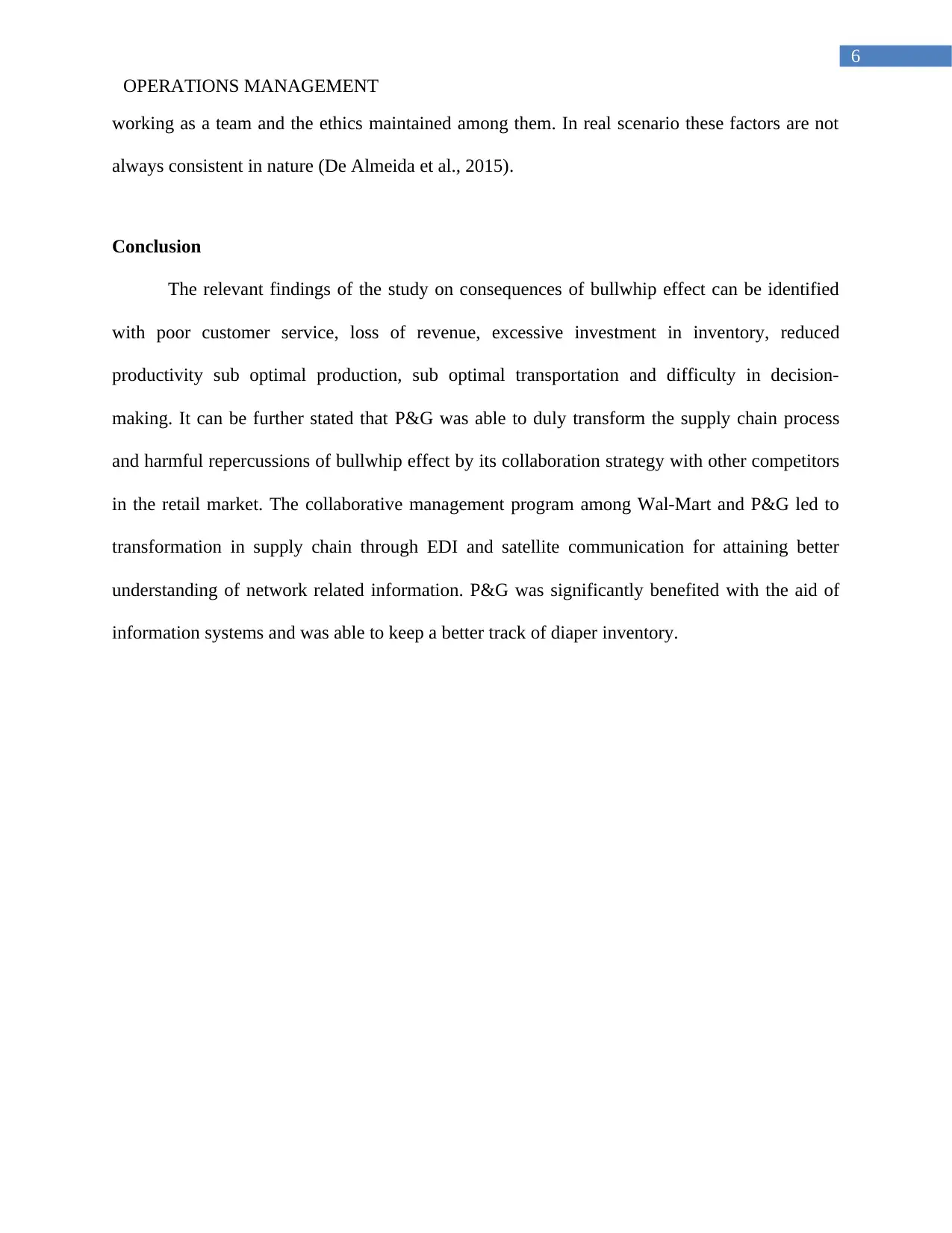
6
OPERATIONS MANAGEMENT
working as a team and the ethics maintained among them. In real scenario these factors are not
always consistent in nature (De Almeida et al., 2015).
Conclusion
The relevant findings of the study on consequences of bullwhip effect can be identified
with poor customer service, loss of revenue, excessive investment in inventory, reduced
productivity sub optimal production, sub optimal transportation and difficulty in decision-
making. It can be further stated that P&G was able to duly transform the supply chain process
and harmful repercussions of bullwhip effect by its collaboration strategy with other competitors
in the retail market. The collaborative management program among Wal-Mart and P&G led to
transformation in supply chain through EDI and satellite communication for attaining better
understanding of network related information. P&G was significantly benefited with the aid of
information systems and was able to keep a better track of diaper inventory.
OPERATIONS MANAGEMENT
working as a team and the ethics maintained among them. In real scenario these factors are not
always consistent in nature (De Almeida et al., 2015).
Conclusion
The relevant findings of the study on consequences of bullwhip effect can be identified
with poor customer service, loss of revenue, excessive investment in inventory, reduced
productivity sub optimal production, sub optimal transportation and difficulty in decision-
making. It can be further stated that P&G was able to duly transform the supply chain process
and harmful repercussions of bullwhip effect by its collaboration strategy with other competitors
in the retail market. The collaborative management program among Wal-Mart and P&G led to
transformation in supply chain through EDI and satellite communication for attaining better
understanding of network related information. P&G was significantly benefited with the aid of
information systems and was able to keep a better track of diaper inventory.
Paraphrase This Document
Need a fresh take? Get an instant paraphrase of this document with our AI Paraphraser

7
OPERATIONS MANAGEMENT
References
Costas, J., Ponte, B., de la Fuente, D., Pino, R., & Puche, J. (2015). Applying Goldratt’s Theory
of Constraints to reduce the Bullwhip Effect through agent-based modeling. Expert
Systems with Applications, 42(4), 2049-2060.
Dai, J., Li, S., & Peng, S. (2017). Analysis on Causes and Countermeasures of Bullwhip Effect.
In MATEC Web of Conferences (Vol. 100, p. 05018). EDP Sciences.
De Almeida, M. M. K., Marins, F. A. S., Salgado, A. M. P., Santos, F. C. A., & da Silva, S. L.
(2015). Mitigation of the bullwhip effect considering trust and collaboration in supply
chain management: a literature review. The International Journal of Advanced
Manufacturing Technology, 77(1-4), 495-513.
Devika, K., Jafarian, A., Hassanzadeh, A., & Khodaverdi, R. (2016). Optimizing of bullwhip
effect and net stock amplification in three-echelon supply chains using evolutionary
multi-objective metaheuristics. Annals of Operations Research, 242(2), 457-487.
Nielsen, P., & Michna, Z. (2018). THE IMPACT OF STOCHASTIC LEAD TIMESON THE
BULLWHIP EFFECT–AN EMPIRICAL INSIGHT. Management and Production
Engineering Review.
Us.pg.com. (2018). P&G purpose, values and principles. [online] Available at:
https://us.pg.com/policies-and-practices/purpose-values-and-principles/ [Accessed 10
Sep. 2018].
OPERATIONS MANAGEMENT
References
Costas, J., Ponte, B., de la Fuente, D., Pino, R., & Puche, J. (2015). Applying Goldratt’s Theory
of Constraints to reduce the Bullwhip Effect through agent-based modeling. Expert
Systems with Applications, 42(4), 2049-2060.
Dai, J., Li, S., & Peng, S. (2017). Analysis on Causes and Countermeasures of Bullwhip Effect.
In MATEC Web of Conferences (Vol. 100, p. 05018). EDP Sciences.
De Almeida, M. M. K., Marins, F. A. S., Salgado, A. M. P., Santos, F. C. A., & da Silva, S. L.
(2015). Mitigation of the bullwhip effect considering trust and collaboration in supply
chain management: a literature review. The International Journal of Advanced
Manufacturing Technology, 77(1-4), 495-513.
Devika, K., Jafarian, A., Hassanzadeh, A., & Khodaverdi, R. (2016). Optimizing of bullwhip
effect and net stock amplification in three-echelon supply chains using evolutionary
multi-objective metaheuristics. Annals of Operations Research, 242(2), 457-487.
Nielsen, P., & Michna, Z. (2018). THE IMPACT OF STOCHASTIC LEAD TIMESON THE
BULLWHIP EFFECT–AN EMPIRICAL INSIGHT. Management and Production
Engineering Review.
Us.pg.com. (2018). P&G purpose, values and principles. [online] Available at:
https://us.pg.com/policies-and-practices/purpose-values-and-principles/ [Accessed 10
Sep. 2018].
1 out of 8
Related Documents
Your All-in-One AI-Powered Toolkit for Academic Success.
+13062052269
info@desklib.com
Available 24*7 on WhatsApp / Email
![[object Object]](/_next/static/media/star-bottom.7253800d.svg)
Unlock your academic potential
Copyright © 2020–2025 A2Z Services. All Rights Reserved. Developed and managed by ZUCOL.





